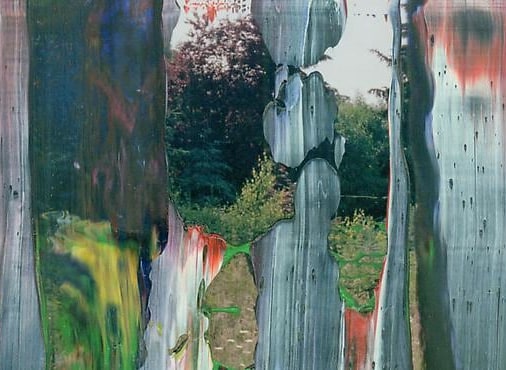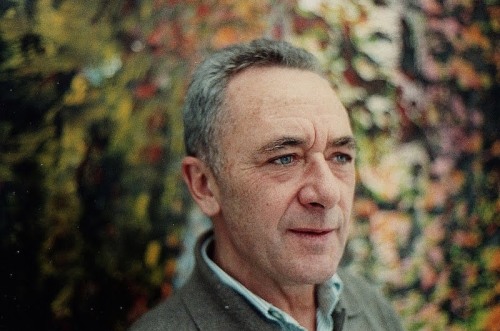

Gerhard Richter (b. 1932) was born in Dresden, Germany. He studied art at the Dresden Hochschule für Bildende Künste from 1951 to 1956, with mural painting as his concentration. In 1959, he visited documenta II, held in Kassel, Germany, an experience that inspired him to alter his artistic trajectory. After his escape from East Germany in 1961, he completed a second course of study at the Staatliche Kunstakademie in Düsseldorf. There, he united with his fellow students Sigmar Polke, Konrad Lueg, and Manfred Kuttner to collectively form the short-lived “Capitalist Realism” group.
Be it a rural landscape, a colorful gestural abstraction, or a black-and-white painting based on a family snapshot or image from the newspaper, a certain set of tensions consistently drives Richter's work: belief versus skepticism, gesture versus erasure, planning versus chance, personal engagement versus objective neutrality. In Richter's paintings one can identify many of the marks, methods, and forms that have driven the development of modern and contemporary art since the 1950s. But the often discordant way in which the artist brings them together on the canvas cools their rhetorical intensity. The restless quality of these works, in which different modes of painting collide, reflects Richter's simultaneous hope and uncertainty that painting can faithfully assess contemporary reality.
From 1964 onward, Richter had many solo exhibitions in renowned commercial galleries in Europe, among them the Galerie Schmela in Düsseldorf (1964); Galerie Friedrich & Dahlem, Munich (1964, 1966); City-Galerie Bruno Bischofberger, Zurich (1966); Galleria La Tartaruga, Rome (1966); Wide White Space, Antwerp (1967); Galerie Heiner Friedrich, Munich (1967); Galerie Rudolf Zwirner, Cologne (1968); and Galleria del Naviglio, Milan (1969).
Richter’s first solo exhibition in a public institution was held at the Gegenverkehr, Zentrum für aktuelle Kunst, in Aachen, Germany, in 1969. In 1972 he was selected as the only artist to represent Germany in its National Pavilion at the Venice Biennale. His work has been presented in numerous solo shows and retrospective exhibitions at important institutions worldwide, including the Kunstverein für die Rheinlande und Westfalen, Düsseldorf (1971, 1986); Kunsthalle Bremen, Germany (1975); Musée national d’art moderne, Centre Georges Pompidou, Paris (1977, 2012); Städtische Kunsthalle, Düsseldorf (1986); Neue Nationalgalerie, Staatliche Museen zu Berlin (1986, 2012, 2023); Hirshhorn Museum and Sculpture Garden, Smithsonian Institution, Washington, DC (1988, 2003); San Francisco Museum of Modern Art (1989, 2002); Tate, London (1991, 2011); Moderna Museet, Stockholm (1993); The Art Institute of Chicago (2002); The Museum of Modern Art, New York (2002); Queensland Art Gallery, Brisbane (2017); The Met Breuer, New York (2020); and The National Museum of Modern Art, Tokyo (2022). Richter has exhibited at documenta, in Kassel, Germany, more times than any other artist (1972, 1977, 1982, 1987, 1992, 1997, 2007, and 2017).
Richter has been honored with a number of significant awards, among them the Kunstpreis Junger Westen, Recklinghausen, Germany (1967); Arnold-Bode-Preis, Kassel, Germany (1981); Oskar-Kokoschka-Preis, Vienna (1985); Goslarer Kaiserring, Goslar, Germany (1988); Golden Lion at the 47th Venice Biennale (1997); Praemium Imperiale Award, Tokyo (1997); Wexner Prize, Wexner Center for the Arts, Columbus, Ohio (1998); Foreign Honorary Membership of the American Academy of Arts and Letters, New York (1998); Staatspreis des Landes Nordrhein-Westfalen, Düsseldorf (2000); and the Kunst- und Kulturpreis der deutschen Katholiken, Bonn, Germany (2004). In 2007 Gerhard Richter received an honorary citizenship of Cologne, Germany, and in the same year he designed a spectacular glass window for the Cologne Cathedral.